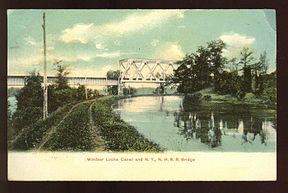Enfield Falls Canal
| Enfield Falls Canal | |
|---|---|

Windsor Locks Canal and railroad bridge (postcard mailed in 1909)
|
|
| Specifications | |
| Length | 5.25 miles (8.45 km) |
| Locks | 1 (north end); 3 (south end) |
| Status | Closed |
| Navigation authority | |
|
Enfield Falls Canal (Windsor Locks Canal)
|
|
| Nearest city | Windsor Locks, Connecticut |
| Area | 55 acres (22 ha) |
| Built | 1829 |
| NRHP Reference # | 76001998 |
| Added to NRHP | April 22, 1976 |
| History | |
| Construction began | 1827 |
| Date completed | November 11, 1829 |
| Geography | |
| Start point | 41°59′12″N 72°36′19″W / 41.9866°N 72.6053°W |
| End point | 41°55′01″N 72°37′29″W / 41.9169°N 72.6248°W |
Enfield Falls Canal (Windsor Locks Canal) is a canal that was built to circumvent the shallows at Enfield Falls (or Enfield Rapids) on the Connecticut River, between Hartford, Connecticut and Springfield, Massachusetts. It is situated along the west side of the river, adjacent to the towns of Suffield and Windsor Locks in Hartford County in the state of Connecticut, USA. Windsor Locks is named after the series of locks on the canal.
Prior to the opening of the canal, the scows or flat-bottomed boats which plied the Connecticut River could only ascend the falls by engaging local fallsmen to propel the craft forward utilizing set poles. One fallsman was required for each ton of cargo. Not only did the added labor costs make this method of overtaking the falls expensive, but the amount of cargo that could be transported was limited to approximately ten tons. Any additional freight had to be offloaded at Warehouse Point on the east bank and warehoused for later transport or carried around the falls by ox teams.
Construction of the canal commenced in 1827 and it was opened on November 11, 1829. The canal was 5 1⁄4 miles (8.4 km) long and had a vertical drop of 32 ft (9.8 m). The locks admitted craft up to 90 ft (27 m) long and 20 ft (6.1 m) wide. The canal was unique among canals of the era in that it was designed with structural reinforcement to facilitate steam tug boat traffic. The design of the canal included a massive head gate with apertures that could be opened and closed to precisely control water levels not only within the lock chambers but within the canal itself. The design feature supported the incorporator's dual intent to profit not only from tolls charged on canal traffic but from the sale of mill sites and the leasing of water rights to mill operators along the last mile of the canal bank.
Once the canal was opened, boats were able to carry much larger loads, and the anticipated steamboat services were introduced using newly designed vessels capable of passing through the lock chambers. Charles Dickens traveled along the canal on February 7, 1842. However, by 1844 the Hartford and Springfield Railroad had started operation, and navigation on the Connecticut River gradually reduced. The profits realized from the sale of water rights proved to be the more lucrative of the canal's two purposes.
...
Wikipedia
